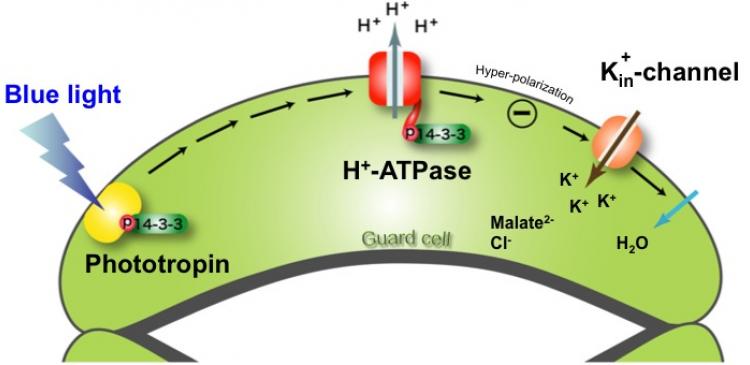Light induces stomatal opening. Abscisic acid (a phytohormone synthesis respond to drought stress), high carbon dioxide, dark may induce stomatal closure. Stomata pore is the essential pathway of carbon dioxide uptake for photosynthesis.
Nagoya, Japan – By determining the key factor in regulating photosynthesis and plant growth, Professor Toshinori Kinoshita, Dr. Yin Wang and co-workers at Nagoya University’s Institute of Transformative Bio-Molecules (WPI-ITbM) have succeeded in developing a method to increase photosynthesis (carbon dioxide uptake) and plant growth through the promotion of stomatal opening. The study, published on the online Early Edition in the week of December 23, 2013 of Proceedings of the National Academy of Science (PNAS), is expected to contribute to the promotion of plant production and towards the development of a sustainable low-carbon society.
Stomata are small pores located on the surface of leaves that control gas exchange with the external environment, and are the primary inlet for the uptake of carbon dioxide (Figure 1). “Stomatal resistance, which suppresses gas exchange through the stomata, is considered to be the major limiting factor for carbon dioxide uptake by plants during photosynthesis,” explains Professor Kinoshita, “very few reports have existed focusing on the induction of stomatal opening. Therefore, we decided to develop a method to manipulate stomatal opening in view of increasing photosynthesis (carbon dioxide uptake) and plant production.”
Kinoshita’s group has already revealed some of the key factors that mediate stomatal opening (Figure 2). The plasma membrane proton (H+)-ATPase or proton pump, an enzyme creating electrochemical gradients in the cell membranes of plants, has been identified as one of the key components. “An increase in photosynthesis (carbon dioxide uptake) by approximately 15% and a 1.4~1.6 times increase in plant growth of Arabidopsis plants was observed by enhanced stomatal opening achieved through overexpression of the proton pump in guard cells that surround the stomata pore,” elaborates Professor Kinoshita (Figure 3).
Professor Kinoshita and his co-workers envisage that application of this method will contribute to the increase in the production of crops and fuel plants as well as towards the reduction of carbon dioxide in the atmosphere. Professor Kinoshita states, “Identifying that the manipulation of stomatal opening is the key limiting factor in photosynthesis and plant growth enables us to consider strategies to solve current issues in food production and carbon emissions.”
This article “Overexpression of plasma membrane H+-ATPase in guard cells promotes light-induced stomatal opening and enhances plant growth” by Yin Wang, Ko Noguchi, Natsuko Ono, Shin-ichiro Inoue, Ichiro Terashima, and Toshinori Kinoshita, is published on the online Early Edition in the week of December 23, 2013 in Proceedings of the National Academy of Science (PNAS).
PNAS 2014, 111, 533-538 DOI: 10.173/pnas.1305438111
This work was supported in part by the Advanced Low Carbon Technology Research Development Program from the Japan Science and Technology Agency and conducted with Professor Ichiro Terashima and Associate Professor Ko Noguchi of the University of Tokyo.
The following program supported this work.
Japan Science and Technology Agency (JST) Strategic Basic Research Program
Advanced Low Carbon Technology Research and Development Program (ALCA)
Research Project: Promotion of photosynthesis and plant productivity through manipulation of stomatal aperture
Research Representative: Professor Toshinori Kinoshita (Nagoya University Institute of Transformative Bio-Molecules)
Research Period: February 2010 – March 2016 (expected)
The JST ALCA program contributes to the reduction of greenhouse gas emissions in the mid and long term and to the realization of a wealthy, low carbon society, aiming to make conceptual breakthroughs and creating “Game-Changing Technology”. ALCA promotes R&D of new basic high-potential scientific knowledge and discovery in order to realize the continual and steady reduction of greenhouse gas emissions.
About WPI-ITbM (http://www.itbm.nagoya-u.ac.jp/)
The World Premier International Research Center Initiative (WPI) for the Institute of Transformative Bio-Molecules (ITbM) at Nagoya University in Japan is committed to advance the integration of synthetic chemistry, plant/animal biology and theoretical science, all of which are traditionally strong fields in the university. As part of the Japanese science ministry’s MEXT program, the ITbM aims to develop transformative bio-molecules, innovative functional molecules capable of bringing about fundamental change to biological science and technology in a Mix-Lab system, where international young researchers from multidisciplinary fields work together. Through these endeavors, the ITbM will create “transformative bio-molecules” that will dramatically change the way of research in chemistry, biology and other related fields to solve urgent problems, such as environmental issues, food production and medical technology that have a significant impact on society.
Author Contact
Professor Toshinori Kinoshita
Institute of Transformative Bio-Molecules (WPI-ITbM), Nagoya University
Furo-Cho, Chikusa-ku, Nagoya 464-8602, Japan
TEL/FAX: +81-52-789-4778
E-mail: [email protected]
Public Relations Contact
Dr. Ayako Miyazaki
Institute of Transformative Bio-Molecules (WPI-ITbM), Nagoya University
Furo-Cho, Chikusa-ku, Nagoya 464-8601, Japan
TEL: +81-52-789-4999 FAX: +81-52-789-3240
E-mail: [email protected]
ITbM Press Office
E-mail: [email protected]
When the guard cells are illuminated with sun light, phototropins respond to the blue light and transduce the light signal into the downstream, and then lead to the activation of the plasma membrane H+-ATPase through the phosphorylation. The activated H+-ATPase induces hyperpolarization of plasma membrane and provides driving force for K+ uptake through the K+ channel in the plasma membrane. Accumulation of K+ in guard cells induces the swelling of guard cells and stomatal opening.
The TG plant produced larger and increased numbers of rosette leaves with about 42–63% greater fresh and dry weights than WT plants for 25-day (A~C). Moreover, the dry weights of total flowering stems in 45-day-old TG plants (D), including seeds, siliques, and flowers, were about 36–41% greater than those of the WT under the same growth conditions.





